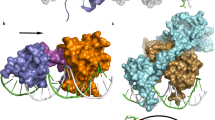Summary
In cell-free systems the addition of antigen stimulates the synthesis of informational RNA (i-RNA) which exhibits the following properties: It codes for the entire antibody molecule, it codes for the synthesis of regulator protein which initiates transcription of i-RNA with the correspondent informational content from DNA, it is a template for an an i-RNA dependent RNA polymerase, it is a template for an i-RNA dependent reverse transcriptase. The i-RNA may exist in a state of latency in cells. The product of reverse transcription of i-RNA is i-DNA which can be used to transcribe further i-RNA of the same specificity. Similar to i-DNA is an extracellular DNA which codes also for antibody and from which i-RNA can be transcribed. The data presented are summarized in a scheme of the flow of information during immunological reactions.
It could be shown that there exist three different types of extrachromosomally synthesized molecules — i-RNA, i-DNA and extracellular DNA — which bear immunological specific information. These extrachromosomal states of information may be relevant for the generation of antibody diversity.
Similar content being viewed by others
Abbreviations
- i-RNA:
-
informational RNA
- i-DNA:
-
informational DNA
- AAP:
-
antibody analogous product
- BPoFlys:
-
benzoyl-penicilloyl-formyl-l-lysine
- HSV:
-
Herpes simplex virus
- HBs:
-
Hepatitis virus B, surface antigen
- HBsad :
-
Hepatitis virus B, surface antigen, subtype ad
- HBsay :
-
hepatitis virus B, surface antigen, subtype ay
- PPD:
-
purified protein derivative of tuberculine
- i-RNARk :
-
i-RNA decoding for antibody against Rk
- i-RNAR5 :
-
i-RNA coding for antibody against R5
- R5:
-
receptor particle for phage T5, derived from E. coli
- Rk:
-
receptor particle for phage kappa, derived from Serratia marcescens
- SDS:
-
sodium dodecyl sulfate
- PBS:
-
phosphate buffered saline
References
Dienert, F., 1900. Ann. Inst. Pasteur (Paris) 14, 139.
Ehrlich, P., 1900. Proc. roy. Soc. 66, 424.
Edelman, G. M. et al., 1969. Proc. Nat. Acad. Sci. 63, 78.
Jerne, N. K. et al., 1963. In: Cell bound Antibodies p. 109. Eds. Amos, B. and H. Koprowski Wistar Institute Press Philadelphia.
Ingrahan, J. S. and Bussard, A. E., 1964. J. exp. Med. 119, 667.
McDevitt, H. O. and Sela, M., 1965. J. exp. Med. 122, 517.
Bagley, D. W. and Hoste, J., 1971. Transplantation 11, 404.
Blomberg, B. et al., 1972. Science 177, 178.
Bluestein, J. G. et al., 1972. J. exp. Med. 135, 98.
Jachertz, D., 1966. Z. med. Mikrobiol. Immunol. 152, 1.
Jachertz, D., 1973. Ann. N.Y. Acad. Sci. 207, 122.
Jachertz, D., 1968. Z. med. Mikrobiol. Immunol. 154, 245.
Davis, R. W. et al., 1971. In: Methods in Enzymology 21D, 413. Eds. Grossman, L. and Moldawe K. Academic Press, New York.
Jachertz, D. et al., 1975. J. of Immunogenetics 2, 231.
Robberson, D. et al., 1971. J. molec. biol. 60, 473.
Jachertz, D. 1966. Z. med. Mikrobiol. Immunol. 152, 20.
Drescher, J. and Jachertz, D., 1966. Zbl. Bakt. I. Abt. Orig. 199, 315.
Jachertz, D. and Noltenius, H., 1966. Z. med. Mikrobiol. Immunol. 152, 112.
Drescher, J. et al., 1962. J. Immunol. 89, 805.
Jachertz, D. In: Immune RNA in Neoplasia. Academic Press, New York.
Strohmaier, K. and Mussgay M., 1959. Z. Naturforsch. 14b, 171.
Bremer, H. et al., 1966. J. molec. Biol. 16, 104.
Pauling, L., 1940. J. amer. chem. Soc. 62, 2643.
Jerne, N. K., 1955. Proc. Nat. Acad. Sci. (USA) 41, 849.
Jerne, N. K., 1971. Europ. J. Immunol. 1, 1.
Wu, T. T. and E. A Kabat., 1970. J. exp. Med. 132, 211.
Prokop, O. and G. Bundschuh. Die Technik und die Bedeutung der Haptoglobuline und Gm-Gruppen in Klinik und Gerichtsmedizin. W. de Gruyter Berlin, 1963.
Naterig, J. B. and Kunkel, H. G., 1968. Series Haematologica II/1, 66.
Jachertz, D., 1967. Z. med. Mikrobiol. Immunol. 153, 257.
Jachertz, D., 1966. Z. med. Mikrobiol. Immunol. 152, 262.
Neuhoff, V. et al., 1970. Hoppe-Seyler's Z. physiol. Chem. 351, 157.
Jachertz, D. et al., 1972. Z. Immun.-Forsch. 144, 260.
Gottlieb, A. A. and Schwartz, R. H., 1972. Cell Immunol. 5, 341.
Roelants, G. E. and Goodman, J. W., 1969. J. exp. Med. 130, 557.
Friedman, H. P. et al., 1965. Science 149, 1106.
Askonas, B. A. and Rhodes, J. M., 1965. Nature 205, 470.
Penner, P. E. et al., 1971. Nature, New Biology 232, 58.
Opitz, H.-G. et al., Hoppe-Seyler's Z. physiol. Chem. 353, 740.
Anker, P. et al., 1975. Cancer Res. 35, 2375.
Anker, P. et al., 1976. Cancer Res. 36, 2832.
Rogers, J. C. et al., 1972. Proc. Nat. Acad. Sci. (USA) 69, 1685.
Rogers, J. C., 1976. Proc. Nat. Acad. Sci. (USA) 73, 3211.
Harris, G., 1975. Immunology 29, 469.
Harris, G., 1975. Immunology 29, 687.
Jachertz, D. et al. 1979. Immunology (in the press).
Author information
Authors and Affiliations
Rights and permissions
About this article
Cite this article
Jachertz, D. Gene activation during immune reaction. Mol Cell Biochem 24, 93–126 (1979). https://doi.org/10.1007/BF00314890
Received:
Issue Date:
DOI: https://doi.org/10.1007/BF00314890




